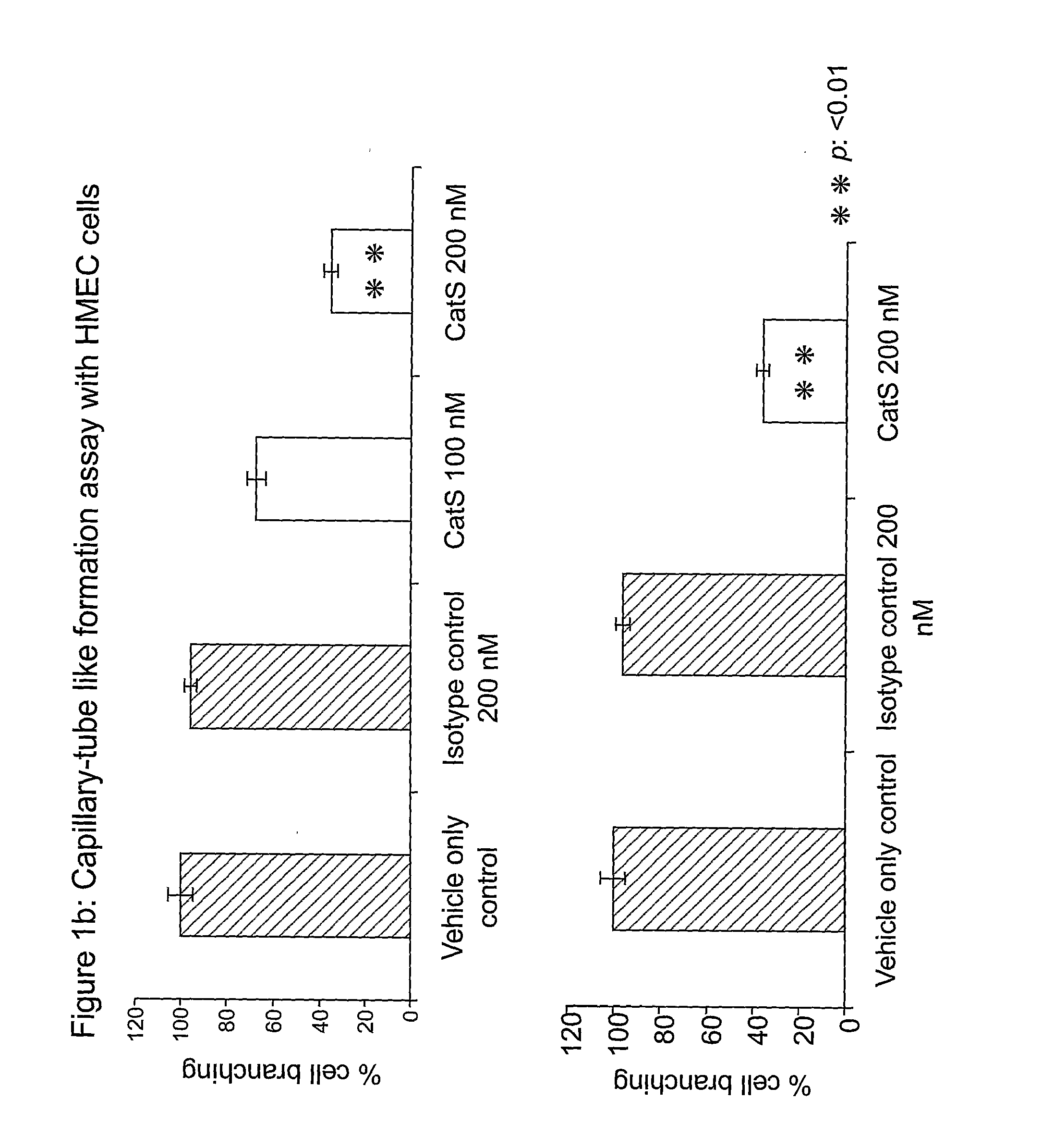Antibody and uses thereof
an angiogenesis and anti-cell technology, applied in the field of angiogenesis-related conditions and diseases, can solve the problems of cathepsin-s activity, and the inability to achieve the treatment of diseases, and achieve the effect of reducing the risk of angiogenesis
- Summary
- Abstract
- Description
- Claims
- Application Information
AI Technical Summary
Benefits of technology
Problems solved by technology
Method used
Image
Examples
example 1
CatS Antibodies can Inhibit Tube-like Formation in Human Endothelial Cells
[0161]Using the Matrigel morphogenesis assay described by (Grant D S, Tashiro K, Segui-Real B, Yamada Y, Martin G R, Kleinman H K. Two different laminin domains mediate the differentiation of human endothelial cells into capillary-like structures in vitro. Cell. 1989 Sep 8;58(5): 933-43.), capillary-tubule formation assays were performed with human microvascular endothelial cells (HMECs) cultured on Matrigel enabling the endothelial cells form tube-like structures, with invasive sprouts extending from individual cells to form contacts with nearby endothelial cells. FIG. 1a illustrates the results when the HMEC cells were cultured in the presence of two CatS antibodies (1E11 and 1E4) or isotype control. Extensive tube-like structures are evident in the vehicle-only control and isotype control antibody (200 nM) panels; however, this tube formation is almost completely abolished in the presence of the 1E11 or 1E4...
example 2
CatS Antibodies can Inhibit Tube Like Formation in Rat Aortic Arch ex vivo Model
[0163]To evaluate further the role of CatS in angiogenesis, an ex vivo rat aortic arch assay was performed. Sections of the aorta (1 mm) were cultured within a thin layer of Matrigel in the presence of the inhibitory antibody and appropriate controls. The formation of tube-like vessels from the aorta were monitored and quantified after 7 days by measuring the reduction in the number of vessels, mean vessel length and maximum vessel length compared to controls.
[0164]FIG. 2 illustrates the significant inhibition of tube formation in the presence of the CatS 1E11 antibody. Photographs of the ring segments are shown in FIG. 2a with the results summarized in FIG. 2b. Incubation of the rat aortic ring segments with up to 600 nM of 1E11 resulted in greater than 80% reduction in total vessel number, mean vessel length and maximum vessel length (FIG. 2b).
[0165]FIG. 3 illustrates the significant inhibition of tube...
example 3
[0166]To investigate the effect of the CatS antibodies on tumor invasion, an invasion assay was performed as described above using HCT 116 cells. The results are shown in FIG. 4. As can be seen, tumor invasion was significantly attenuated in HCT 116 cells treated with the CatS 1E11 antibody and in HCT116 cells treated with the 1E4 CatS antibody.
PUM
| Property | Measurement | Unit |
|---|---|---|
| Fraction | aaaaa | aaaaa |
| Composition | aaaaa | aaaaa |
Abstract
Description
Claims
Application Information
 Login to View More
Login to View More - Generate Ideas
- Intellectual Property
- Life Sciences
- Materials
- Tech Scout
- Unparalleled Data Quality
- Higher Quality Content
- 60% Fewer Hallucinations
Browse by: Latest US Patents, China's latest patents, Technical Efficacy Thesaurus, Application Domain, Technology Topic, Popular Technical Reports.
© 2025 PatSnap. All rights reserved.Legal|Privacy policy|Modern Slavery Act Transparency Statement|Sitemap|About US| Contact US: help@patsnap.com



